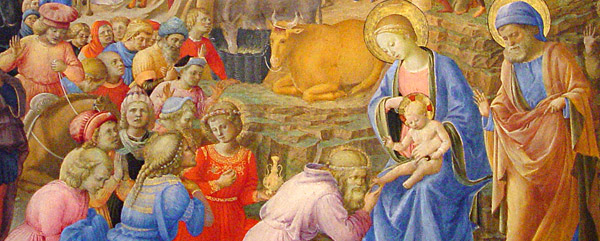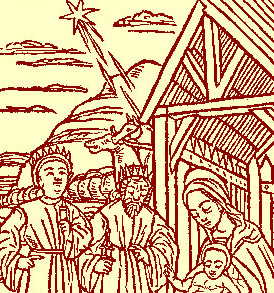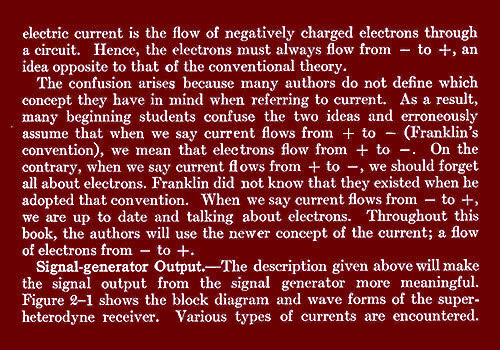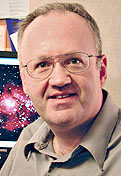 |
|
|
BOOK SALE — I'm selling off some scholarly books via Amazon Marketplace. Have a look!
HIGH-TECH GARAGE SALE — I'm selling off some telescope accessories and electronic parts. Have a look at that too!

|
2007
December
28-31
|
Miscellany
I've remarked before that Series I savings bonds are a good deal.
Too good a deal... Now the Treasury
won't
let you buy more than $5,000 of savings bonds per year.
Did I send them too many customers? :)
Property-tax "work-off" programs for senior citizens such as
this one are being promoted as a boon for
older people who would otherwise be unable to afford their property taxes.
I'm skeptical. To me, it smacks vaguely of enslavement. If it were actually intended
to help senior citizens, it would at least credit them appreciably more than the
minimum wage. More to the point,
if property taxes are unaffordable, they should be lowered!
Here is the place
to get small coin-cell and button-cell batteries in bulk, cheaply. Note that the cheap LR44 and the
more expensive SR44 (still affordable at his site) seem interchangeable, but many cameras require the SR44.
Numerous small hand-held tools, flashlights, etc., use the LR44, and if voltage regulation is
not needed, the SR44 is a waste of money.
Back in 1909 General Electric
built an electric motor that is still in use in Colorado. That's 98 years so far...
Barring unforeseen developments — which certainly could happen — I'm going to close out
the year now. I'll be back on January 1, probably with a bumper crop of material, and then there will
be one or two additional hiatuses in early January before things settle down. Happy new year!
Permanent link to this entry


|

|
2007
December
27
|
Christmas tree without foliage
Here's what we did for a Christmas tree this year. Melody has been making these
elaborate sequined ornaments for years, from
kits.
This year we decided that instead of being on the Christmas tree,
they would be the Christmas tree.

Note the delicacies at the left: Jones Soda for Sharon, Coca-Cola for me, Dingo Bones
for Babbage and Tycho.
Permanent link to this entry
The Megan Meier tragedy
On a sadder note, my comments on the tragic death of Megan Meier
are here.
I can only assume that the facts of the case are as reported in the media
(for example, here).
It is truly sad how the Internet seems to cause otherwise civilized people
to lose touch with reality.
Let me hammer home the point again:
Real people are the only kind there are.
Whenever anybody does anything to someone else on the Internet,
there's a real human being on each end.
They do not lose their reality just because they're at the other end of a wire,
even if you don't know who they are, and even if you're playing a game
(neither of which was the case in this incident).
Permanent link to this entry
The weird world of online matchmaking
There's a catfight going on in the
online
matchmaking industry.
The people who run Match.com and Chemistry.com
are disparaging eHarmony.com for being too conservative.
Putting it bluntly, Match.com and Chemistry.com (a single company)
are for "dating" (i.e., apparently, casual sex)
while eHarmony tries to build successful marriages. The founder of eHarmony is indeed a Christian
and the service is based on the Christian concept of marriage. That doesn't make it a Christian
organization — people of any religion, or none, are welcome. But if you're going to prepare
people for marriage, you have to have a definite concept of what marriage is, and they do.
So Match.com, alias Chemistry.com,
is reportedly going to disparage them with negative ads full of an attitude worthy of a
high-school locker room. It's the same old story:
Those of us who succeed at monogamy and faithfulness get ridiculed by those who don't.
Do they think the public is going to like all this negative advertising?
The slogan is going to be "Rejected by eHarmony." Isn't that likely to
promote eHarmony as the more respectable agency?
"If you want somebody who isn't promiscuous, go to our competitor."
Comments from Match.com seem to imply that eHarmony is trying to make everybody "live by the same rules."
No, not everybody. Only its customers. Everyone is free to not be a customer.
I've even heard a Match.com radio ad that was apparently catering to married people
wanting to have affairs. Yuck.
Update: Someone has just pointed out to me that
there's also a point of law to be considered.
If you're in the business of setting people up for sexual encounters, at
what point do you cross the line from matchmaking into pimping?
Permanent link to this entry
Miscellanea oeconomica
(Yes, in Latin it's oeconomica.)
Meanwhile, regarding the banking industry,
three
professors opine
that:
- The subprime mortgage crisis involved a great deal of deception or misrepresentation — people would
not have accepted those mortgages if they had understood what they were doing;
- Mortgages should be classified as "standard" and "nonstandard," with everyone being warned that the
nonstandard kind are riskier.
The analogy is to "opt-out" retirement plans, where you get a safe retirement plan unless you go to
some effort to avoid it.
In my opinion, this isn't a complete solution. Didn't a lot of those subprime borrowers plan to
get rich off the "bubble"? They could have been given better advice, but maybe they wouldn't have
believed it. Surely a lot of them did know that they were getting riskier-than-normal mortgages.
Didn't they?
One last economic note. Elise Glink recently remarked on her radio show that gift cards are changing
the nature of Christmas shopping by shifting purchases into the post-Christmas markdown period.
If gift cards are widely used, suddenly there's no pre-December-25 shopping frenzy. Hmmm...
Speaking of shopping frenzies, don't miss the action on
eBay!
Permanent link to this entry


|

|
2007
December
26
|
eBay sale!
I'm cleaning out my closets. To see what sort of things my (highly technological) closets contain,
click here.
I'll continue adding things all evening on the 25th and maybe into the 26th.
Permanent link to this entry


|

|
2007
December
25
|

Has the Star of Bethlehem been explained away?
Minor updates 2008 January 6.
The cover of the December 2007 issue of Sky and Telescope proudly
proclaims, "The Star of Bethlehem Explained." Have they really explained it?
I don't think so.
I wrote about the Star of Bethlehem on
Christmas 2004,
and I stand by everything I said then.
Today I want to respond to Sky and Telescope's article
and also point out some other new developments.
The article in question is "Science, Scholarship, and Bethlehem's
Starry Night," by Aaron Michael Adair (Sky and Telescope,
December 2007, pp. 16-29). Adair argues that the Gospel of Matthew
misuses astronomical terminology, contradicts the Gospel of Luke regarding
the date of Jesus' birth, was written nearly 100 years after that event anyhow,
and is generally so unreliable that "a historian can only regard the tale
as fictional or at least not investigable." The theory is that
ancient people wanted to
believe that kings were born under miraculous circumstances, so in order
to crown Jesus as King, they made up this story.
Well... not so fast.
First, Matthew should not be expected to use Greek terminology precisely.
According to ancient tradition, his gospel was originally written in Hebrew or
Aramaic (which has much less precise terminology)
and then translated into Greek.
Even if this is not so, it is overwhelmingly likely that he was a native speaker
of Aramaic and had no Greek astronomical education.
And he surely got his information about the birth of Jesus from people who spoke
Aramaic, not Greek.
Second, if
the Gospel of Matthew was indeed written near 100 A.D.
(which is not what most
scholars now think), it was definitely based on older material.
Third, there are a number of proposals for resolving the
contradiction between Matthew and Luke; maybe modern readers are mixing up
Herod the Great with Herod Antipas, or maybe the census of Quirinius
mentioned by Luke is not the same as the one described by the ancient historian Josephus.
(Or could Luke have meant just that
this census was like the one conducted by Quirinius?)
And even if the contradiction indicates a genuine error, that doesn't make the gospels
fictional or mythological. An error of fact can only arise if you are trying to
report facts.
It's true that Matthew's description of the star is very vague. That's just what we'd
expect. But it's a long way from vague to "fictional." The rest of the Gospel of Matthew
is clearly not fiction; the matter-of-fact style makes it clear that its author intended
to give a detailed account of actual events, even when he didn't understand them.
It has been pointed out elsewhere that there is a kind of pious Jewish fiction called
midrash ("interpretation") that might be involved here... but as far as I can tell,
midrash always makes a concise doctrinal point
and does not get tangled up with real historical characters and events.
Nor do I assume that, when dealing with ancient history, the speculations of post-Enlightenment
scholars are worth more than the testimony of the ancients themselves.
People in the ancient world weren't stupid, and they knew more about the
ancient world than we do. For what it's worth, the early Christians were
unanimous that Matthew himself
wrote the Gospel (perhaps as early as 40 A.D.) and that the Magi were real.
Whether or not they were right, the fact that they held this belief is a fact that
ought to be entered into evidence.
Finally, note that if you dismiss the story as fiction, you stop investigating it,
so if it's not fiction after all, you may never know. Anyhow, the argument that it is
fiction is abductive,
not deductive,
which means it can only give you a hypothesis, not a certainty.
So, all things considered,
I think something happened in the sky at that first Christmas,
whether or not we are able, in modern times, to find out any more about it.
And that brings me to my second point. Keep reading...
Permanent link to this entry

How could the Star of Bethlehem lead the Magi to Jesus?
The biggest astronomical puzzle in the story
is how the Star of Bethlehem led the Magi to Jesus.
Matthew says that the star "went before [the Magi]
until it came to rest over the place where the child was" [ESV].
The leading explanation has been that "came to rest" meant that it stopped
some kind of celestial motion, such as the apparent stopping of a planet's
orbital motion temporarily as the earth overtakes it.
But that's not very satisfying.
The puzzle may have been cracked by James C. Sentell
(Link updated),
who points out an interesting optical illusion. For the illusion, you need:
- A landscape with numerous identifiable hilltops or mountain peaks at various distances;
- A star or other object high in the southern sky and setting, so it's moving toward the west;
- Observers who are moving south or southeast.
Under these conditions, hills southwest of the observers will also tend to move toward
due west, and at the right combination of hill distance and observers' speed, a hill can remain
directly under a star. That's how the star could "come to rest" above a specific location.
I think this is an important insight, and it stands separately from Sentell's identification
of the Star of Bethlehem with a particular comet. (By the way, we know a comet can look like a star;
we saw Comet Holmes do it a couple of months ago. And if it looks like a star, people who don't
know the stars won't notice anything unusual in the sky.)
Note that Sentell is not proposing anything miraculous; he's just solving a problem of ancient
history. Non-Christians can perfectly well agree with him.
We wish all of you a blessed Christmas. Venite, adoremus Dominum.
Permanent link to this entry


|

|
2007
December
24
(Extra)
|
Comets, Moon, and Mars
I'm not ready to write my Christmas entry (which will be about the Star of Bethlehem),
but here's something that's ready to go, so here it is, dated December 24.5 (I suppose).

Comet Holmes is big, bloated, and hard to see against the moonlit sky. (This is a very contrast-enhanced
photo.) You're looking at the whole field of a 300-mm lens, so the comet must be 2 degrees in diameter,
or more. It has kept the same shape while literally blowing up like a balloon.
Stack of five 30-second exposures, automatic dark frame subtraction in camera. Canon EOS 40D, 300-mm lens.
Now here's Comet Tuttle, same technique, six images stacked, enlarged to about 2 times the scale of
the one above. Despite being seventh magnitude, this comet has a much higher surface brightness:

Finally, while all this was going on, the Moon passed right next to Mars and I snapped this
picture using the same camera on a fixed tripod:

This was a spectacular sight; Mars looked much brighter than the picture suggests.
Permanent link to this entry


|

|
2007
December
24
|
Fixing all the computers in the house...
We're spending Christmas weekend fixing computers. Some things I've learned recently:
If you get the message "Choose the program you want to use to open this file"
when you're opening a disk drive, it's because the drive has a hidden, malformed
AUTORUN.INF file on it.
More advice
here.
I regret that I didn't dig deeper and look at what was in AUTORUN.INF before I deleted it.
On another machine I needed to use Recovery Console to
replace
a file in \WINDOWS\SYSTEM32.
But when I booted it from the installation disk, Recovery Console wouldn't take the
administrator password, even though it was correct.
Apparently this is a known bug. The
workaround
is to install Recovery Console as a Windows component and
set a local security policy to automatically log on the administrator.
The computer is then at risk of tampering if a malicious person can sit down at it...
but in our house that isn't a problem.
If a PC refuses to install .NET Framework updates, the solution is apparently
here.
(Explanation here
and here. It has
to do with security updates being installed before the .NET versions that should precede them.)
Tedious, but it seems to work.
[Addendum:] Microsoft's instructions are a bit vague. I think what they
mean is: Uninstall all the versions of .NET Framework, and if there are any you can't uninstall,
use the Cleanup Utility to delete them. That makes the installer forget they're installed, so that
you can do a clean install on top of them.
Permanent link to this entry
Miscellany
There are two comets in the evening sky (along with a full moon to keep us from seeing them,
and Mars right next to the moon).
Comet Holmes is still there in Perseus, probably at 4th magnitude but very spread out,
passing in front of the star Algol,
and Comet Tuttle is in Cassiopeia.
Details here.
Cathy reports that our dog Tycho is afraid of
my microscope.
He thinks it's a black creature that sits on its haunches and glares at him with its
two big eyes...
Merry Christmas to you and yours!


|

|
2007
December
23
|
[Corrections and additions made since initial upload.]
Norton Antivirus blocks incoming e-mail (port 110)
Last night I was up until the wee hours trying to fix numerous malfunctions of our home server,
a Windows XP machine. The most prominent symptom was that Melody's account could not receive
e-mail. After probing around a while, I determined that port 110 (POP3) was blocked. For example,
the command:
telnet mail.bellsouth.net 110
did not give a connection.
The culprit turned out to be Norton Antivirus 2006, which fixed itself when I ran LiveUpdate.
However, curiously, during the malfunction, turning off Norton e-mail scanning didn't fix the
problem, and that threw me off the trail for a while.
I did learn that, in its 2006 incarnation, Norton is too idiot-proof. If you turn off
e-mail scanning, you get constant pop-up messages telling you to turn it back on. You don't get to
make your own decision.
As my old colleague Bob Stearns says, "If you a make a system totally foolproof,
only fools will [be able to] use it." The bracketed words are my own addition.
I am no longer recommending Norton Antivirus. Well-respected competitors include McAfee and Kaspersky.
Permanent link to this entry
Newtonmas?
December 25 is probably not the actual birthday of Jesus Christ, but it is
the birthday of Sir Isaac Newton,
at least if you don't convert from Julian to Gregorian.
I got a mass mailing wishing me a "Merry Newtonmas." Hmmm...
Permanent link to this entry
Removing ferric chloride stains
The other day, in our robotics lab, I gave a demonstration of making a printed
circuit board. I used ferric chloride etchant because it doesn't require heating.
Unfortunately, I spilled a few drops of the etchant on a vinyl anti-static mat that was somewhat
porous. As you know, ferric chloride is yellowish-brown, a lot like rust, and tends to
stain everything it touches. So despite some cleanup attempts with water and various
cleaning products, there was a stain.
Today (Dec. 22) I got the stain out, mostly. I made a paste of citric acid and water
and left it on the stain for 2 hours. That removed about 80% of the stain.
I may go at it again with citric acid and hot water. I'm told that oxalic acid
is more effective, and that it's sold as DAP Wood Bleach, but I didn't have any.
Addendum: I'm told that oxalic acid is also the active ingredient in Bar Keepers Friend powder
(not liquid). If so, this should be just the thing for removing FeCl stains.
Another addendum: This
source indicates that FeCl stains can be decolorized by phosphoric acid, i.e., Coca-Cola.
I'll have to try that. As close as the nearest vending machine!
Permanent link to this entry


|

|
2007
December
22
|
Miscellany
Recommended product:
Kilz Upshot,
a spray paint that sprays straight up and is
tinted to match aging ceilings.
I tried it on a couple of old stains just now.
It works!
LDO voltage regulators:
I've recently been looking at low-dropout voltage regulator ICs,
and the LM2937 series seems
particularly useful. There are fixed 15-, 12-, 10-, 8-, 5-, 3.3-, and 2.5-volt versions.
Input to 60 V; safe on automotive electrical systems; and protected against reverse
battery connection. Unlike the old familiar 7805, this one requires a 10-μF tantalum
capacitor on the output, which adds a whopping 35 cents to the cost of the circuit.
Web scraping:
I've also been looking at software to retrieve information automatically from Web sites.
No conclusions yet, but
promising products are
here
and here.
The scientific study of fights:
One of the seminal books connected with the
terrorism research that I'm now doing
is Tilly's The Politics of Collective Violence.
It's more entertaining than the title suggests; the second paragraph of the preface (page xi)
is not to be missed. Read much of it
on Google Books, free.
Finally, something to blow your mind:
Jabberwocky
has been translated into Latin.
Just as in English, about a third of the words make perfect sense, and
the rest look like they belong where they are, even though you can't quite
tell what they mean.
It's been translated into
other
languages, too.
Permanent link to this entry


|

|
2007
December
21
|
Hazards of being an electronics hobbyist
From the Dec. 20 Athens Banner-Herald (right here in Athens, Georgia):
Science project mistaken for bomb
The "bomb" discovered in the gym at Jackson County Comprehensive High School on Monday
night turned out to be discarded science project, according to Jefferson police Chief Joe Wirthman.
"The kid evidently got a 92 on the project, and I guess he just left it behind," Wirthman said.
A cleaning crew found a package containing a circuit board wrapped in wires in the school's
gym about 9:30 p.m. Monday and assumed it was bomb. Police evacuated the cleaning crew and
a group of students practicing for a choral concert to the other side of the building while
the Georgia Bureau of Investigation's bomb squad destroyed the package.
Officials at first thought someone was trying to disrupt Tuesday's final exam schedule,
but subsequent investigation revealed the package was part of a science project dealing
with radio waves, Wirthman said. The student earned an A on the project, he said.
When wires are outlawed, only outlaws will have wires?
Permanent link to this entry


|

|
2007
December
20
|
How engineers and computer geeks approach religion
The most interesting book I've seen this year is
God's
Mechanics, by Guy Consolmagno,
a Jesuit brother who is a professional astronomer.
I won't try to summarize it here. Instead, click on the link and read some
sample pages. Key idea: Technically adept people have a distinctive approach to
information and life, and it has special strengths and weaknesses.
And much of what is said publicly about religion is talking right past them.
To Consolmagno's many interesting observations I'll add one more: Good computer
programmers are familiar with the idea of thinking in more than one system.
If you can ask how to copy a file under Windows and under Linux, you might equally
well ask how a particular moral insight is expressed in Christianity and also in
Judaism or Islam. That's the kind of question that comes naturally to a techie.
Permanent link to this entry


|

|
2007
December
19
|
Economic news
Not everyone realizes that
U.S. taxes on the very rich
have gone
up appreciably in the past 15 years.
The richest 1% of the population earns 21% of the total income and pays 39% of the total taxes.
Is it wrong for 1% of the population to earn 21% of the income? Socialists think so, and so do a good
many other people. But think a minute. If you got rid of the rich people who are earning it now,
would that income even exist? It's not as though they get the money automatically; many of them
are conducting highly valued, high-risk ventures that simply couldn't be done without unusual resources.
You have to remember that some business ventures are like horse races — you really don't know
whether you're going to win, and if the potential rewards aren't high, you won't even enter the race.
This is not to defend all "rock-star salaries" as Ross Perot called them. Shareholders need to think
about whether they are overpaying their CEOs. But that is an issue of how companies are run, not how the
country is run.
I am more concerned about whether working people are starving or otherwise suffering from poverty.
If it can lift the other 99% out of poverty, I'm in favor of letting the top 1% earn as much
as possible.
In other news, today
the Fed
proposed the regulations
that we should have had 5 years ago to prevent the subprime mortgage crisis.
(You've seen this in the news media; follow my link to get full information from
the official source.)
The new rules just require that banks behave rationally,
which is exactly what they weren't doing.
Who in his right mind would lend $200,000 to someone without verifying his
ability to pay it back?
One provision is more subtle. Mortgages have to be prepayable without penalty during
at least the 60 days
preceding each payment increase. That gives people a window of opportunity to refinance.
If you lure them into a bad deal, you can't hold them.
What else do we need?
A
national usury law.
Permanent link to this entry


|

|
2007
December
18
|
All I want is a straight Christmas card...
I went shopping for Christmas cards today and came home empty-handed.
The Christmas cards in the store fell into four categories, all unsuitable:
- Niche marketing:
"GRANDMOTHER, Merry Christmas to my GRANDMOTHER, GRANDMOTHER!" (with variations for Aunt, Uncle,
Cousin, etc., seemingly all the way down to Brother-in-Law's Ex-Boss).
- Party-animal weird. What is a martini glass doing on a Christmas card? I didn't waste any
time trying to find out.
- The excessively politically correct: snowflakes, snowmen, polar bears, fun, and no mention
of any particular holiday.
- At the other extreme, "Jesus is the reason for the season, so you'd better get to church
right now!"
The message I'd like to send is this: "Many of us are celebrating the birth of Jesus Christ.
On this occasion I extend to you my best wishes, whatever your personal religious commitment may be."
I gave up and made Christmas cards for just a few people. I don't send Christmas cards in bulk,
so please don't feel left out if you didn't get one. Have a Merry Christmas anyway!
Permanent link to this entry
Dan Fogelberg, 1951-2007
We note with sadness the death of singer Dan Fogelberg.
To the extent that Melody and I have an "our song," it is his song, "Longer."
Permanent link to this entry
Comet Holmes, still there

Comet Holmes has changed little during the past fortnight.
This is a low-quality image — a single 3-minute exposure taken on December 17 (0300 UT),
grainy because of the contrast stretching necessitated by the moonlight.
The bright star is Kappa Persei.
Permanent link to this entry


|

|
2007
December
17
|
Will health-care costs go down?
One of the hot issues in modern economic policy is what to do about
the skyrocketing cost of health care.
The major reason the cost is going up, of course, is that there's more to buy.
Nobody wants to drop back to 1970s levels of medicine
(no CAT scans, no MRI, no cardiac stents)
just to get back to 1970s prices.
Still less would anyone want to go back to 1890.
To put it crudely, none of us is volunteering to die sooner just to save money.
Some economists point out that it may just be a fact of modern life that from
now on a substantial amount of the cost of living is going to be medical care.
It's a new expense, comparable to the way, in the past several decades, a substantial
part of the cost of living has come to be gasoline. A person in 1900 might have
panicked at the thought of how much we'd spend on gasoline in the early 2000s.
But today I want to offer a strange new hypothesis:
Health-care costs may turn around and start going down in the future.
Why do I think this? Because other areas of high technology have done it.
Look at the cost of computers, for instance. The cost of computing machines
shot up from 1940 to 1970 for the same reason as health care today —
there was more to buy. Technological advances made more computer power
available at every step, but it was costly.
Then another wave of technical advances reversed the trend, and
since 1975 or so, the cost of computer power has been plummeting.
Similar things have happened with consumer electronics (thanks to the
transistor and IC) and various kinds of machinery. With automobiles, the price
drop is hidden. We pay higher prices than in the 1970s, of course,
but we also get much higher quality. No one is willing to buy the cheap
stuff that the auto industry was selling 40 years ago, so it isn't made.
The cost per level of quality has, I would argue, gone down.
Could anything like that happen to medical care?
Can we at least think about the possibility?
Permanent link to this entry


|

|
2007
December
15-16
|
60 years of transistors
December 16 marks the 60th anniversary of
the invention of the transistor
at Bell Laboratories.
This is one of two inventions that made electronics what it is.
The other, much earlier, was the invention of the vacuum tube
by Lee De Forest in 1906.
Both a tube and a transistor are amplifying devices — they allow a very
small electric current to control a larger one. It's like having a valve which is operated
by a trickle of water, so that a much larger stream can mimic the fluctuations in the smaller
one. They don't just turn the big stream on and off; they mimic every fluctuation, so that,
for example, the small voltage from a microphone can produce a matching but larger voltage
in a speaker.
Vacuum tubes are easy to understand.
There are two electrodes, one of them hotter than the other.
(That's why tubes light up; they all contain heating elements.)
Electrons go from the hot electrode to the cooler one, and along
the way, they pass through a grid made of wire screening, which has
a negative charge and repels electrons.
By varying the amount of negative charge, you can vary the current
passing through the tube.
Transistors are much harder to visualize. I'll skip over the early point-contact transistor,
which even I don't understand, and say simply that in a junction transistor,
you have 3 layers of silicon, with different impurities, and when you pull a small
current from layer 1 into layer 2, as a side effect it allows a much larger current
to flow into layer 3.
Because transistors are made of solid matter — in fact the same kind of solid
matter throughout, except for small amounts of impurities — they can be made very small.
You can make a transistor out of a single chunk of silicon by adding different impurities
in various places. That's how integrated circuits are made. Integrated circuits contain
hundreds or millions of transistors on a single silicon wafer. That's how we get computers
that fit in our pockets instead of occupying whole buildings.
I think the tube and the transistor were great inventions. The integrated circuit was important,
but not an invention on the same level, in that it didn't require so much creative
insight. Almost as soon as transistors were invented, the path to the IC was straightforward.
Permanent link to this entry


|

|
2007
December
14
|
Who remembers PLATO?
Who remembers
PLATO?
I had access to the Urbana PLATO system, complete with its orange-on-black graphics
terminal and 1200-baud acoustically coupled modem,
in 1976 and showed it to Melody on one of our first dates.
Culturally, it strongly prefigured the Internet.
Permanent link to this entry


|

|
2007
December
13
|
Cursed with success

The official North American release of
my latest book
isn't until next month, but it's out — and selling out —
in Europe already.
I'm told the first load reaching New York is mostly presold.
The good news is that if you do get a copy from the first shipment,
you'll probably get it well ahead of the scheduled date.
Or so I'm told.
E-mail overflow:
My research and teaching are keeping me very busy, and this situation will continue for several
weeks. Please understand that I have less than the usual amount of time to answer e-mail.
My books have 10,000 readers and I cannot
correspond with everyone individually, much as I'd like to.
Thanks!
|
Permanent link to this entry


|

|
2007
December
12
|
Mars in detail

Here, at last, is a reasonably respectable image of Mars. 8-inch telescope, 1500 frames of
video stacked and processed with RegiStax 4.0. Unusually mild weather, about 55 F at 10:30 p.m.,
resulting in steady air. The streaky, jerky look of the picture is due to processing, but a
remarkable amount of genuine detail is visible. I may try to process the same video file
again with different parameters.
Permanent link to this entry


|

|
2007
December
11
|
Did I photograph a satellite mishap?
(No; it was a rocket booster.)
When I stepped outside around 7:05 p.m. on the evening of December 10, there was a bright
comet in the sky, or so I thought — very similar to Comet Holmes but in a different
place (Lacerta or northern Andromeda) and much brighter and somewhat bigger (-1 magnitude,
more than 1 degree in diameter).
Through binoculars it showed a sharp-pointed internal structure.
Through the 8-inch telescope I saw two 10th-magnitude starlike spots moving across the sky
and a plume of gas
apparently issuing forth from a point somewhat behind one of them.
I got a couple of quick pictures with the EOS 40D and a 105-mm lens
piggybacked on the telescope. Here's a
20-second exposure taken at 19:11 EDT:

Important: This picture is trailed. The two streaks that you see are actually
dots, and the whole structure is smeared the same amount in the same direction. It actually
comes to a sharp point.
[Revised]
So what was it? At first I thought it was an existing satellite that had come to grief,
but in fact it's been tentatively identified as the
spent upper stage of an
Atlas-Centaur rocket that was making quite a show, jettisoning propellant,
above Florida about 15 minutes before I saw it.
Given the direction of motion, northeastward,
that sounds right.
Permanent link to this entry


|

|
2007
December
10
|
What are we to make of The Golden Compass?
[Minor revision Dec. 11.]
I haven't seen The Golden Compass and don't plan to. But here's a quick guide
to the hoopla about it:
- It is a fact that the author (Philip Pullman) is trying to promote atheism and undermine
religion. That isn't just a rumor started by religious people.
Detailed confirmation is available on Snopes.
- That is not a novelty; much of Hollywood's output has been visibly biased against religion,
and especially against Christianity, for quite a while.
- There are reliable reports that The Golden Compass is just not a very good movie,
that its message has been watered down and obscured and the whole thing is confusing.
- I am concerned that the controversy about atheism
is being whipped up deliberately, to promote what is
otherwise a forgettable piece of work.
- Jeff Duntemann,
a theologically knowledgeable Christian who is also an
experienced science fiction author and critic,
dislikes The Golden Compass for a different set of reasons than you might expect.
He says Pullman has distorted the Church to the point of unrecognizability, so it's no longer
evident what he's attacking.
Another correspondent writes to confirm this.
And there I'll leave it. I don't want to be a pawn in a publicity game.
Permanent link to this entry
Miscellany
Here's the scoop
on Windows Vista Service Pack 1, which is going to be a genuine improvement.
If this picture
is genuine, someone has been rather brazenly counterfeiting capacitors, and doing it in a way
that almost guarantees that the fake one won't pass for the real one. (Notice the lower capacitance
and voltage ratings on the real capacitor inside the fake one.) Weird. The electronics
industry has been plagued by counterfeit power transistors, which generally are substitute transistors with similar
characteristics but lower power-handling capacity.
But this particular caper strikes me as a crime of stupidity because anyone with a capacitance
meter could catch it.
If you like funny mistranslations,
read
this (and scroll down to the picture of the Chinese-English menu).
Latest tactic by environmental wackos:
lying to the news media.
Just the way to win our trust, folks!
Permanent link to this entry


|

|
2007
December
9
|
Mars again

Here's a slightly better view of Mars. Same equipment as a few days ago, but
better atmospheric conditions. Mars is still appreciably farther from the earth
than during its close approach two years ago. The large dark area at the bottom
left is Mare Acidalium (Acidalia Planitia).
Permanent link to this entry


|

|
2007
December
8
|
Comet Holmes, still growing

Comet Holmes is still growing — and still glowing.
As of the evening of Dec. 3, when I took this picture, it had returned to naked-eye
visibility thanks to the absence of the moon from the sky.
The comet is now a round patch appreciably larger than the moon.
Here you see it at a scale of 10 arc-seconds per pixel, the same
as last month, but as you can see, it is outgrowing
the picture size and I'll have to scale it down further in the future.
At the bottom left is the star cluster NGC 1245.
The picture is a stack of five 3-minute exposures taken from my yard
in Athens, Georgia, with a 300-mm lens.
I also used a 105-mm lens for this much-wider-field view, showing the Alpha
Persei star cluster (large and spread out) with its ghostly interloper:

Permanent link to this entry


|

|
2007
December
7
|
M33, in town

Digital cameras are surprisingly good at subtracting out the background glow of the city sky.
Here's a picture of M33 that I took the other night — or rather my camera took it while
I was inside doing housework. This is a stack of six 3-minute exposures with a 300-mm lens.
Compare it to the dark-sky picture of M33 that I took
in October.
The arrow points to a nebula, NGC 604, which is part of the galaxy M33; if you lived in that
galaxy, it would be a very fine sight.
Permanent link to this entry


|

|
2007
December
6
|
Miscellany
I'm often amused at the words people use to describe items they are selling on eBay.
Today's funny one: "8mm video film camera".
Folks, it's not "video film." It's "movie" or "motion picture."
Guess what?
Even Macintoshes
don't actually work by magic.
They have just the same failure modes as Windows PCs.
And why shouldn't they? They're almost the same machines.
The Apple Macintosh is a state of mind, not a computer technology.
Permanent link to this entry


|

|
2007
December
5
|
News notes
Microsoft is going to
do away with "reduced functionality mode"
in copies of Vista that fail to authenticate.
From now on, copies of Vista that appear to be pirated will display warnings
but will still run everything.
That is a long-overdue move because it takes away a
glaring opportunity for cyber-sabotage.
If an enemy power could corrupt someone at Microsoft, tamper with the authentication
process, and make all copies of Vista go into reduced functionality mode,
they could (in the future, when Vista has penetrated more of the market)
cripple our nation's computers. Operating systems shouldn't have bombs built into
them like that.
Meanwhile, people are spending money on "virtual gifts"
(mostly adornments to display on people's Facebook pages).
A fool and his money... At least you get more for your dollar for this
than if you buy a lottery ticket.
Permanent link to this entry


|

|
2007
December
4
|
Mars from a long way off
 Mars is back in sight again, although it's not going to come as close to the earth as two years ago.
This is a rather poor picture taken in unsteady air; it's the best 1000 of 1500 video frames taken
through my 8-inch telescope. The dark spot near the top is known as Solis Lacus.
Mars is back in sight again, although it's not going to come as close to the earth as two years ago.
This is a rather poor picture taken in unsteady air; it's the best 1000 of 1500 video frames taken
through my 8-inch telescope. The dark spot near the top is known as Solis Lacus.
Permanent link to this entry


|

|
2007
December
3
|
The so-called Gospel of so-called Judas
Remember the "Gospel of Judas," which the
National Geographic Society unveiled with great fanfare
in April 2006?
It was supposed to overturn our understanding of the beginning of Christianity.
Well,
Biblical scholar
April DeConick of Rice University,
who reads Coptic and other ancient languages,
has another surprise for us:
The National Geographic Society's version of the Gospel of Judas was
so badly mistranslated as to change the entire message of the book.
When translated correctly, it is a much less interesting document, definitely
not a first-person account from Judas, but merely another Gnostic attempt to
twist early Christianity into something else. And we already knew there were
plenty of those.
Quoting Dr. DeConick's
article in the New York Times:
|
It was a great story. Unfortunately, after re-translating the society’s transcription of the Coptic text, I have found that the actual meaning is vastly different. While National Geographic’s translation supported the provocative interpretation of Judas as a hero, a more careful reading makes clear that Judas is not only no hero, he is a demon.
Several of the translation choices made by the society’s scholars fall well outside the commonly accepted practices in the field. For example, in one instance the National Geographic transcription refers to Judas as a “daimon,” which the society’s experts have translated as “spirit.” Actually, the universally accepted word for “spirit” is “pneuma” — in Gnostic literature “daimon” is always taken to mean “demon.”
Likewise, Judas is not set apart “for” the holy generation, as the National Geographic translation says, he is separated “from” it. He does not receive the mysteries of the kingdom because “it is possible for him to go there.” He receives them because Jesus tells him that he can’t go there, and Jesus doesn’t want Judas to betray him out of ignorance. Jesus wants him informed, so that the demonic Judas can suffer all that he deserves.
Perhaps the most egregious mistake I found was a single alteration made to the original Coptic. According to the National Geographic translation, Judas’s ascent to the holy generation would be cursed. But it’s clear from the transcription that the scholars altered the Coptic original, which eliminated a negative from the original sentence. In fact, the original states that Judas will “not ascend to the holy generation.” To its credit, National Geographic has acknowledged this mistake, albeit far too late to change the public misconception.
|
What was it St. Paul said about people having itchy ears?
Some people wanted to tell a good story here, and others wanted to believe it whether or not it
was accurate. And I'm talking about 21st-century writers, not early Christians.
Permanent link to this entry


|

|
2007
December
1-2
|
Some forgotten classics of technical writing

An important stage in my own intellectual development occurred when, some time before
my tenth birthday, I read
Practical
Radio Servicing, by William Marcus and Alex Levy.
Here at last was a book that actually explained how things work, rather than just
assuming that I already mostly knew. It only explained one thing — the 5-tube AC/DC radio,
already obsolescent by the time I was reading about it — but it explained every component.
That's the right way to teach electronics: no hand-waving.
I particularly thank the authors for defining "ground" as "common negative" and making do without
the ground symbol for the first few pages.
As far as I know, the text of that book is not on line, but it has a big brother,
which you see here.
Marcus and Levy wrote a more comprehensive tome, Elements of Radio Servicing,
which went through at least three editions from 1947 to 1967 and is available in the
Internet Text Archive.
It's equally lucid, and equally obsolete but still (in my humble opinion) worth reading
(and essential if you want to fix antique radios).
The prose style does not strike me as elegant, but all the information is presented clearly
and in the right order, with considerable attention to
what is going on in the head of the reader.
That is, the authors don't put ideas on paper — they put them into the student's mind.
All this is relevant because I'm revising some of my own
introductory electronics notes for students,
and the project may grow into a book.
Incidentally, this William Marcus is not to be confused with Abraham Marcus,
who wrote a competing book, nor John Markus, whose
Television and Radio Repairing was
also an important part of my early education.
In those days, introductory electronics books always focused on radio and TV
repair because everyone imagined the job market was going to grow tremendously.
Instead, as manufacturing costs fell, the consumer-electronics repair industry
dwindled to its present state.
Happy First Sunday in Advent!
Look back a year or two for Notebook entries specifically about this holy season.
Permanent link to this entry


|

|
| |
Entries are most often uploaded around 0000 UT on the date given,
which is the previous evening in the United States.
| |





















 Mars is back in sight again, although it's not going to come as close to the earth as two years ago.
This is a rather poor picture taken in unsteady air; it's the best 1000 of 1500 video frames taken
through my 8-inch telescope. The dark spot near the top is known as Solis Lacus.
Mars is back in sight again, although it's not going to come as close to the earth as two years ago.
This is a rather poor picture taken in unsteady air; it's the best 1000 of 1500 video frames taken
through my 8-inch telescope. The dark spot near the top is known as Solis Lacus.
